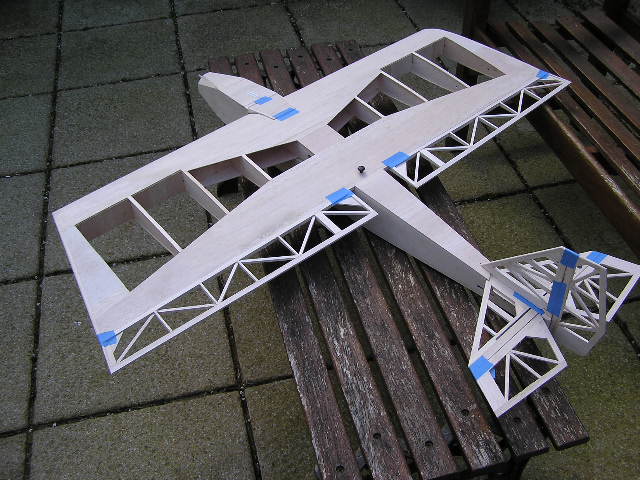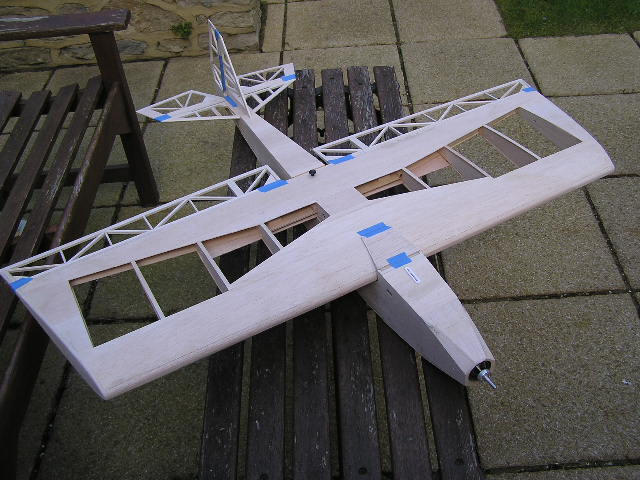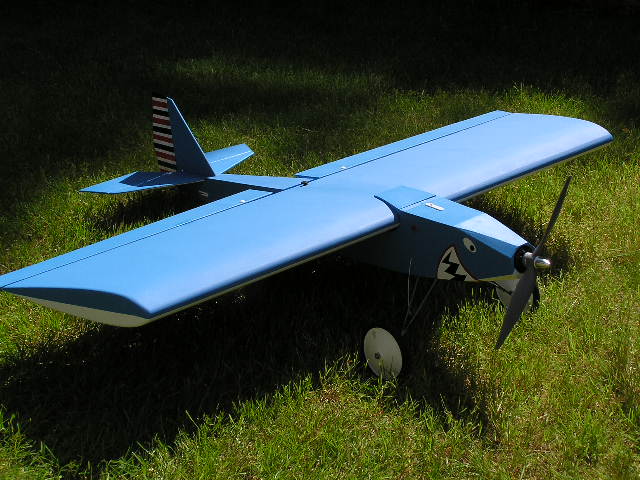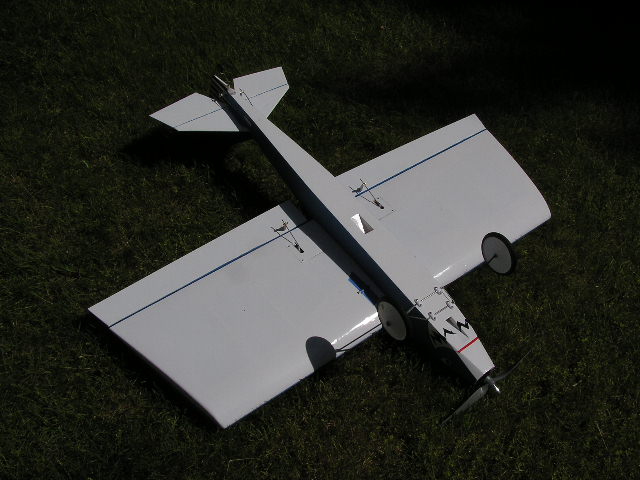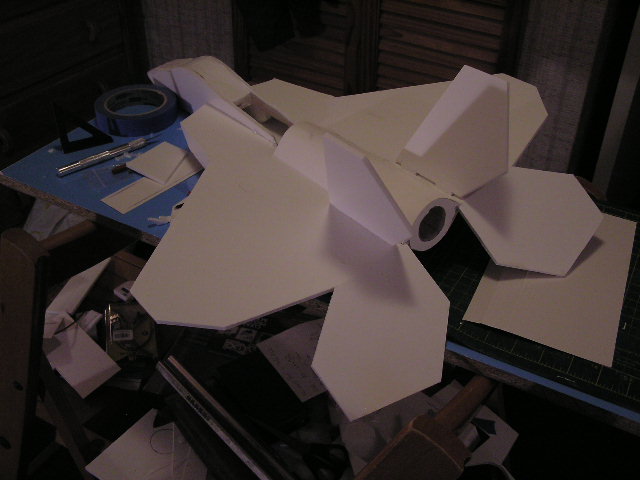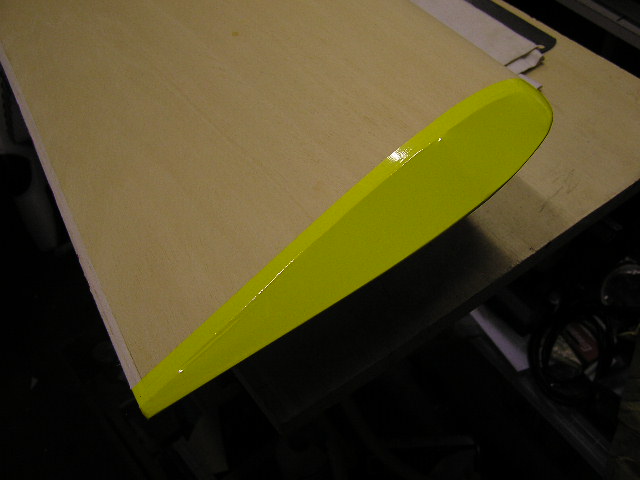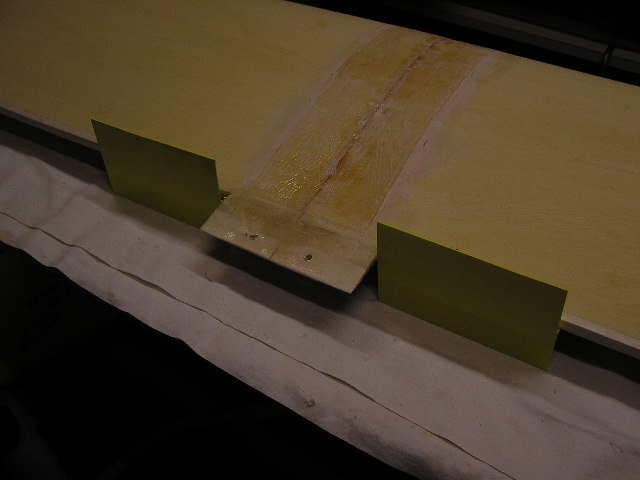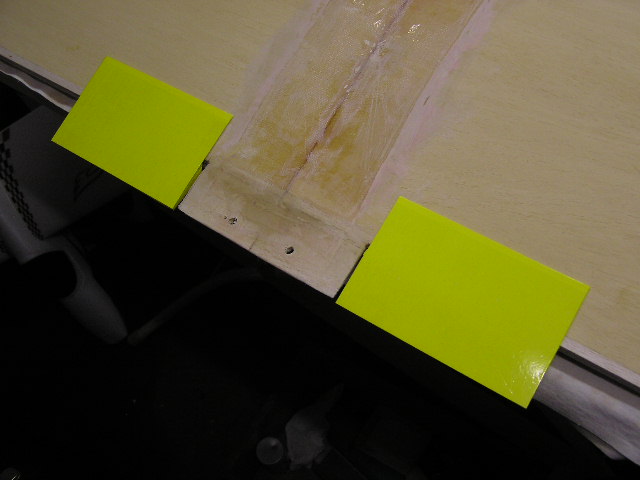- Posts: 1045
- Thank you received: 415
Back to Basics
- Brian
-
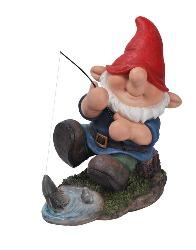 Topic Author
Topic Author
- Offline
- Platinum Member
-

Less
More
2 years 7 months ago #26460
by Brian
Replied by Brian on topic Back to Basics
Last Autumn, I bought a kit for a "Bill Kits Big Fun", it was supposed to be a "Winter Project", and was one of a group of eleven (I think) that would be flown as a Club Model in the PMFC Dorset 2023 season. I looked at the bits in the kit and was pleased that it was all good old fashioned stuff, no brown laser cuts anywhere, and thank goodness, no bonfire smell from the opened kit packet. There didn't seem to be too many parts and there was a good deal of 3" and 4" sheet included, I made the mistake of thinking that the model wouldn't take too long to build, so I decided to put it away until the New Year. January 2023 passed all too quickly, and I was a month late in my intented start to the build. I managed to get all the parts built, and I did put it up for judging with nine other examples of the model. That was on March 9th.
For some reason, more often than not, I seem to manage to introduce a problem for myself. This time it was the power train. I'd chosen a motor/ESC combination that was in my box of useful things, the model spec. said that the finished weight was 2lb.12oz. The motor I had was suitable for a model weighing 1.5Kg. marginal perhaps, but it should fly. Unfortunately I had completely forgotten that the airframe is only a proportion of the finished weight. The actual weight is in the region of 2.5Kg. I called on the excellent services of George at 4Max, who had a suitable motor/ESC for the model. Unfortunately I had well and truly built in the first motor, it wasn't just a case of removing four screws and doing a swap, the nose had to be sawn off to gain access, and the motor mount shortened to suit the new longer motor. During the nose mods. I altered the nose profile from a nearly square section to eight sided and quite sharply tapered.
When I started the build, I thought it might be a good idea to alter the profile of the model a bit, previous experiences from flying as one of a group showed that different colour schemes don't really help once you've let your concentration slip and you're searching the group for your own model. The wing has raked tips, to go with the tapered nose, the tail assembly is slightly larger than the original design, but is buit up rather than mainly sheet construction, and the profiles are based on my memories of my old Flair Magnattila. The fuselage is about 1/2" deeper and 2" longer than the original. The ailerons are built up rather than the sheeted items shown on the plan.
I had intended to cover the model in Diatex, but I left it in its postage tube in the shed. It was very hot for a while last Summer, the Diatex turned from a roll of off white fabric to a cream coloured rod of plastic that's about half an inch in diameter and is almost impossible to unroll.
For some reason, more often than not, I seem to manage to introduce a problem for myself. This time it was the power train. I'd chosen a motor/ESC combination that was in my box of useful things, the model spec. said that the finished weight was 2lb.12oz. The motor I had was suitable for a model weighing 1.5Kg. marginal perhaps, but it should fly. Unfortunately I had completely forgotten that the airframe is only a proportion of the finished weight. The actual weight is in the region of 2.5Kg. I called on the excellent services of George at 4Max, who had a suitable motor/ESC for the model. Unfortunately I had well and truly built in the first motor, it wasn't just a case of removing four screws and doing a swap, the nose had to be sawn off to gain access, and the motor mount shortened to suit the new longer motor. During the nose mods. I altered the nose profile from a nearly square section to eight sided and quite sharply tapered.
When I started the build, I thought it might be a good idea to alter the profile of the model a bit, previous experiences from flying as one of a group showed that different colour schemes don't really help once you've let your concentration slip and you're searching the group for your own model. The wing has raked tips, to go with the tapered nose, the tail assembly is slightly larger than the original design, but is buit up rather than mainly sheet construction, and the profiles are based on my memories of my old Flair Magnattila. The fuselage is about 1/2" deeper and 2" longer than the original. The ailerons are built up rather than the sheeted items shown on the plan.
I had intended to cover the model in Diatex, but I left it in its postage tube in the shed. It was very hot for a while last Summer, the Diatex turned from a roll of off white fabric to a cream coloured rod of plastic that's about half an inch in diameter and is almost impossible to unroll.
The following user(s) said Thank You: 4Pedalsfly, kevinross, Phil Ford, ruggerbloke
Please Log in or Create an account to join the conversation.
- Brian
-
 Topic Author
Topic Author
- Offline
- Platinum Member
-

Less
More
- Posts: 1045
- Thank you received: 415
2 years 4 months ago - 2 years 4 months ago #26515
by Brian
Replied by Brian on topic Back to Basics
The finished Big Fun rolled out yesterday. I had one final snag which left me baffled for almost a morning. When the fuselage was finished, I set up the rudder and elevator servos as well as the ESC. It was gratifying to have the motor running the right way first time. With the wings assembled, I set up the aileron servos, then tried to run the motor before finally fitting the prop. No response to throttle at all. Went through the set up procedure for the ESC again, still no response. Finally remembered that I'd used the "Gear" switch on the Spektrum DX 8 to act a second safety switch to be used when the model was armed and ready for flight, makes handling the model a bit safer. Flipping the Gear switch brought the motor to life, finally I was able to fit the prop. If I'd made notes, and remembered to read them, I'd have saved myself a lot of time .
The wheels are 3D printed and the design is based on the wheels produced by Williams Bros/Flair. They are around 3" diameter. I've used these to be able to fly the model from grass, the wheels supplied with the kit were OK, but were too small to handle the sort of spongy mix of moss and grass that is at Cashmoor.
I still can't believe that a model that I thought would take a couple of weeks to build and a few evenings to cover and set up has taken close to four months. I suppose its the fact that it has been a pretty erratic time, and I can only spend a short time in the workshop (messy junk filled shed) at any one time.
Tomorrow I'll dust of the Moonglow after a long Winter wait, and with luck, just might finish it before next Winter sets in.
The wheels are 3D printed and the design is based on the wheels produced by Williams Bros/Flair. They are around 3" diameter. I've used these to be able to fly the model from grass, the wheels supplied with the kit were OK, but were too small to handle the sort of spongy mix of moss and grass that is at Cashmoor.
I still can't believe that a model that I thought would take a couple of weeks to build and a few evenings to cover and set up has taken close to four months. I suppose its the fact that it has been a pretty erratic time, and I can only spend a short time in the workshop (messy junk filled shed) at any one time.
Tomorrow I'll dust of the Moonglow after a long Winter wait, and with luck, just might finish it before next Winter sets in.
Last edit: 2 years 4 months ago by Brian.
The following user(s) said Thank You: 4Pedalsfly, kevinross
Please Log in or Create an account to join the conversation.
- Phil Ford
-

- Offline
- Administrator
-

Less
More
- Posts: 3170
- Thank you received: 903
2 years 4 months ago #26516
by Phil Ford
Replied by Phil Ford on topic Back to Basics
Please Log in or Create an account to join the conversation.
- Brian
-
 Topic Author
Topic Author
- Offline
- Platinum Member
-

Less
More
- Posts: 1045
- Thank you received: 415
2 years 4 months ago #26517
by Brian
Replied by Brian on topic Back to Basics
Phil, I have a "depth perception" problem even though the runway is a lot wider now. I have a bent MIG 15 and a Hawk with a busted U/C leg to prove it.
Anyway, if you were short like me, you'd be more aware of how long the grass really is.
Anyway, if you were short like me, you'd be more aware of how long the grass really is.
The following user(s) said Thank You: Phil Ford
Please Log in or Create an account to join the conversation.
- Brian
-
 Topic Author
Topic Author
- Offline
- Platinum Member
-

Less
More
- Posts: 1045
- Thank you received: 415
2 years 1 month ago - 2 years 3 weeks ago #26644
by Brian
Replied by Brian on topic Back to Basics
Once again Summer arrived, and as usual, due to other commitments, the flying I planned to do just didn't happen. The Big Fun was finally maidened and by sheer luck flew straight off the board. It was flown with 30g of ballast for the first flights, this precautionary extra weight was taken out, giving a much better "feel" to the model and it has proved to be a solid performer, and although I did poorly in the initial "Concours" ( Skeletons don't score many points in a beauty contest), and I missed the first active round of the Phoenix Club Model Comp, but with one more competition day to go, the Big Fun is placed in the middle of the pack. Not too bad considering the poor start.
As I've been unable to go out to fly, some of the time I've spent "tidying" my sheds. In reality, all that happened was that the mess was redistributed to give myself some working room. It more or less worked, and apart from scrapping a load of puffed LiPos, I re-arranged the space taken up by my ready to fly models. One thing that came out of doing this was the rediscovery of my old Super Air. This model was one of a group of six which we used to more or less fly in formation at the Phoenix Club field. That was 2016 and the last time the model flew. A couple of weeks a go I hauled it out into the daylight and after a good dusting off and a wipe over with a damp cloth, I undid all the electrical connections and treated them all to a touch of contact cleaner (Deoxit D100L). I flushed out the tank and fuel line with new fuel, what a waste? Not when you consider the result of a dead engine when the model is in an awkward place, like over trees and down wind. I fitted a new LiFe Po4 flight battery, filled the tank, and with the engine still at the settings used all those years ago, it started and ran without missing a beat. I've managed five or six flights so far and apart from the mopping up oil after each flight it has been really good to be flying with an engine again.
The Super Air is a very plain model, but its looks belie the performance and it does most aerobatics in a competent manner, as well as enabling me to gain some much needed confidence again. The Moonglow hasn't been forgotten, just temporarily abandoned! There really isn't much in the way of major building to do, but small details do take longer than one allows for. One sort of model has been popular with some of the Phoenix flyers, a concoction of foam board powered by an EDF.
These models of the F-22 Raptor originated from an American outfit called "Flite Test", there's a free download on the Internet. I've started to make one, its taking me a long time, mine is a scaled down version powered by a 40mm EDF. I've added an augmenter tube hoping that it will give a bit more than the claimed 400g thrust of the bare EDF. The total weight of all the parts is just under 300g so it might fly if I'm careful with the extra bits required for finishing..
As I've been unable to go out to fly, some of the time I've spent "tidying" my sheds. In reality, all that happened was that the mess was redistributed to give myself some working room. It more or less worked, and apart from scrapping a load of puffed LiPos, I re-arranged the space taken up by my ready to fly models. One thing that came out of doing this was the rediscovery of my old Super Air. This model was one of a group of six which we used to more or less fly in formation at the Phoenix Club field. That was 2016 and the last time the model flew. A couple of weeks a go I hauled it out into the daylight and after a good dusting off and a wipe over with a damp cloth, I undid all the electrical connections and treated them all to a touch of contact cleaner (Deoxit D100L). I flushed out the tank and fuel line with new fuel, what a waste? Not when you consider the result of a dead engine when the model is in an awkward place, like over trees and down wind. I fitted a new LiFe Po4 flight battery, filled the tank, and with the engine still at the settings used all those years ago, it started and ran without missing a beat. I've managed five or six flights so far and apart from the mopping up oil after each flight it has been really good to be flying with an engine again.
The Super Air is a very plain model, but its looks belie the performance and it does most aerobatics in a competent manner, as well as enabling me to gain some much needed confidence again. The Moonglow hasn't been forgotten, just temporarily abandoned! There really isn't much in the way of major building to do, but small details do take longer than one allows for. One sort of model has been popular with some of the Phoenix flyers, a concoction of foam board powered by an EDF.
These models of the F-22 Raptor originated from an American outfit called "Flite Test", there's a free download on the Internet. I've started to make one, its taking me a long time, mine is a scaled down version powered by a 40mm EDF. I've added an augmenter tube hoping that it will give a bit more than the claimed 400g thrust of the bare EDF. The total weight of all the parts is just under 300g so it might fly if I'm careful with the extra bits required for finishing..
Last edit: 2 years 3 weeks ago by Phil Ford.
The following user(s) said Thank You: 4Pedalsfly, kevinross
Please Log in or Create an account to join the conversation.
- Brian
-
 Topic Author
Topic Author
- Offline
- Platinum Member
-

Less
More
- Posts: 1045
- Thank you received: 415
1 year 6 months ago - 1 year 6 months ago #26791
by Brian
Replied by Brian on topic Back to Basics
Last year, during one of the seemingly never ending storms, a very tall pine tree, situated within a few feet of the bottom of my garden, took on a distinctly dangerous looking downwind tilt. I reported it, but was told not to worry. I tried not to, but a couple of hundredweight of leaning and creaking pine tree over my head, caused me to have severe doubts as to whether I could get out of my shed should the darned thing decide to complete its fall. Just after Christmas we had another bout of high winds, the tree gave up, it didn't fall far, just against the next downwind tree that had a dead branch stuck out. Now the leaning tree is held by a relatively thin, dead branch. I reported it again, and within a few weeks, a jolly chap with a camera came and took photos of the tree. That was early in January. When the creaking got extremely loud earlier this week, I 'phoned the tree people at BCP Council. They were polite but couldn't possibly say if or when anything could be done. Now, in desperation, I've had to convert my "storage" shed into a "workshop". I use the term lightly, it is of course simply a place where I could set up my portable workbench and do some proper stuff. This shed is not on the flightpath of a falling pine tree, and might enable me to catch up on several months of relative inactivity.
Today I've made a start on re-covering a Wot 4 Classic that I bought last year, it was basically sound and built well enough, but was suffering from detached covering film here and there, the aileron servo mounts had to be replaced, and the rudder had to be sorted out as it had a distinct "under camber" that I couldn't correct. The original engine was an Irvine .53, I'm replacing it with an OSFS .70 Surpass, and altering the ailerons to incorporate Chris Foss' suggested combination flaps/airbrakes. These might help lower the landing speed caused by the extra weight of the four stroke.
The covering I'm using is new to me, its from 4Max and is a lot cheaper than famous brands. So far the covering has been easy to use, and seems to go round compound curves as long as its stretched and pulled a bit.
Today I've made a start on re-covering a Wot 4 Classic that I bought last year, it was basically sound and built well enough, but was suffering from detached covering film here and there, the aileron servo mounts had to be replaced, and the rudder had to be sorted out as it had a distinct "under camber" that I couldn't correct. The original engine was an Irvine .53, I'm replacing it with an OSFS .70 Surpass, and altering the ailerons to incorporate Chris Foss' suggested combination flaps/airbrakes. These might help lower the landing speed caused by the extra weight of the four stroke.
The covering I'm using is new to me, its from 4Max and is a lot cheaper than famous brands. So far the covering has been easy to use, and seems to go round compound curves as long as its stretched and pulled a bit.
Last edit: 1 year 6 months ago by Brian. Reason: Spelling
The following user(s) said Thank You: 4Pedalsfly
Please Log in or Create an account to join the conversation.
Moderators: DaveBright
Time to create page: 0.346 seconds
Latest Posts
-
-

- Ray Ivey's Models
- In WimborneMac Members / For Sale - Exchange - Wanted
- by Brian
- 1 week 4 days ago
-
-
-

- Various Gliders from Dave Ambrose ex W.M.A.C Membe...
- In WimborneMac Members / For Sale - Exchange - Wanted
- by 4Pedalsfly
- 2 weeks 6 days ago
-
©
2009 - 2025
WMAC PCF Design

